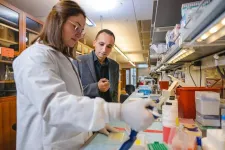(Press-News.org) The Large High Altitude Air Shower Observatory (LHAASO) has discovered a giant ultra-high-energy gamma-ray bubble structure in the Cygnus star-forming region, which is the first time that the origin of cosmic rays with energy higher than 10 Peta-Electronvolt (PeV, 1PeV=1015eV) has been discovered. This achievement was published in the form of a cover article in Science Bulletin on Feb. 26. The research was completed by the LHAASO Collaboration led by Prof. CAO Zhen as the spokesperson from the Institute of High Energy Physics of the Chinese Academy of Sciences. Dr. GAO Chuandong, Dr. LI Cong, Prof. LIU Ruoyu and Prof. YANG Ruizhi are the co-corresponding authors of the paper.
Cosmic rays are charged particles from outer space, mainly composed of protons. The origin of cosmic rays is one of the most important frontier issues in modern astrophysics. Measurements of cosmic rays in past decades have revealed a break around 1 PeV in the energy spectrum (i.e., the distribution of cosmic ray abundance as a function of the particle energy), which is called the "knee" of the cosmic ray energy spectrum due to its shape resembling a knee joint. Scientists believe that cosmic rays with energy lower than the "knee" originate from astrophysical objects within the Milky Way, and the existence of the "knee" also indicates that the energy limit for accelerating protons from most of the cosmic ray sources in the Milky Way is around a few PeV. However, the origin of cosmic rays in the "knee" region is still an unsolved mystery and one of the most intriguing topics in cosmic ray research in recent years.
LHAASO has discovered a giant ultra-high-energy gamma-ray bubble structure in the Cygnus star-forming region, with multiple photons exceeding 1 PeV inside the structure, with the highest energy reaching 2.5 PeV, indicating the presence of a super cosmic ray accelerator inside the bubble, which continuously accelerates high-energy cosmic ray particles with energies of up to 20 PeV and injects them into interstellar space. These high-energy cosmic rays collide with interstellar gas and produce gamma rays. The intensity of these gamma-ray photons is clearly correlated with the distribution of the surrounding gas, and the massive star cluster (the OB association, Cygnus OB2) near the center of the bubble is the most promising candidate for the super cosmic ray accelerator. Cygnus OB2 is composed of many young, hot, massive stars with surface temperatures exceeding about 35,000 °C (O-type stars) and 15,000 °C (B-type stars). The radiation luminosity of these stars is hundreds to millions of times that of the Sun, and the huge radiation pressure blows away the surface material of the stars, forming dynamic stellar winds with speeds up to thousands of kilometers per second. The collision of stellar winds with the surrounding interstellar medium and the violent collision between stellar winds have created ideal sites for efficient particle acceleration. This is the first super cosmic ray accelerator identified as of now. With increasing observation time, LHAASO is expected to detect more super cosmic ray accelerators, and hopefully solve the mystery of the origin of cosmic rays in the Milky Way.
LHAASO's observation has also indicated that the super cosmic ray accelerator inside the bubble significantly increases the cosmic ray density in the surrounding interstellar space, far exceeding the average level of cosmic rays in the Milky Way. The spatial extension of the density excess even exceeds the observed range of bubbles, providing a possible explanation for the excess of diffuse gamma-ray emission from the Galactic Plane previously detected by LHAASO.
Prof. Elena Amato, a renowned astrophysicist from the Italian National Institute for Astrophysical (INAF), highlighted the impact of the discovery on the origin of Cosmic Rays in general. She also commented that these results "not only impacts our understanding of diffuse emission, but has also very relevant consequences on our description of cosmic ray (CR) transport in the Galaxy."
LHAASO is a key scientific and technological infrastructure focusing on cosmic ray research, located at an altitude of 4410 meters on Mount Haizi in Daocheng County, Sichuan Province, China. It is a composite array made up of a one-square-kilometer ground array of 5216 electromagnetic particle detectors and 1188 muon detectors, a 78,000-square-meter water Cherenkov detector array, and 18 wide-angle Cherenkov telescopes. LHAASO was completed in July 2021 and began high-quality and stable operation after that. It is the most sensitive ultra-high-energy gamma-ray detection device in the world. The facility is operated by the Institute of High Energy Physics and adopts a universal international cooperation model to achieve open sharing of facility platforms and observational data. Currently, 32 domestic and foreign astrophysics research institutions have become international collaboration members of LHAASO, with approximately 280 members.
END
LHAASO discovers giant ultra-high-energy gamma-ray bubble, identifying the first super PeVatron
2024-02-22
ELSE PRESS RELEASES FROM THIS DATE:
Method identified to double computer processing speeds
2024-02-22
Imagine doubling the processing power of your smartphone, tablet, personal computer, or server using the existing hardware already in these devices.
Hung-Wei Tseng, a UC Riverside associate professor of electrical and computer engineering, has laid out a paradigm shift in computer architecture to do just that in a recent paper titled, “Simultaneous and Heterogeneous Multithreading.”
Tseng explained that today’s computer devices increasingly have graphics processing units (GPUs), hardware accelerators for artificial intelligence (AI) and machine learning (ML), or digital signal processing units as essential components. These components ...
Home health care linked to increased hospice use at end-of-life, study reveals
2024-02-22
Home health care use in the last three years of a patient’s life is associated with a higher likelihood of hospice care at the end of life, according to a Rutgers Health study.
Researchers, whose findings are published in the Journal of Palliative Medicine, examined the home health care and hospice care experiences of more than 2 million people.
“In addition to benefits for the patient, hospice care also provides resources and support to help family caregivers cope with the physical, emotional and practical challenges of caring for a loved one at the end of life,” said Olga Jarrín, senior author of the ...
Families of men with fertility problems show distinct patterns of increased risk for several types of cancer
2024-02-22
For the first time researchers have identified patterns of risk for several different types of cancer in men with fertility problems and their families.
The study, which is published today (Thursday) in Human Reproduction [1], one of the world’s leading reproductive medicine journals, found that families of men who have very few or no sperm in their semen have a higher risk of developing cancer, including developing cancer at younger ages, compared to families of fertile men.
The risk and the type of cancer varied greatly depending on whether the men had low numbers of sperm (oligozoospermic) or none (azoospermic), with several cancers identified ...
Innovative technology for the comprehensive analysis of membrane protein extracellular interactions.
2024-02-22
1. Background
Many proteins within the body form complexes with other proteins, determining the fate of cells. Therefore, the analysis of protein-protein interactions (PPI) is a crucial process for understanding the biological function of target proteins. Membrane proteins, which account for over 30% of human genes, play a vital role in cell functions. Many membrane proteins are known to form complexes to exert their functions, making the elucidation of membrane protein PPIs essential for understanding protein function. However, the development of technologies to analyze PPIs, especially extracellular protein–protein interactions (exPPIs) of living cells, has ...
Wistar scientists discover link between leaky gut and accelerated biological aging
2024-02-22
PHILADELPHIA—(Feb. 21, 2024)—The Wistar Institute’s associate professor Mohamed Abdel-Mohsen, Ph.D., has demonstrated, with his lab and collaborators, a connection between viral damage to the gut and premature biological aging. The group found that this pro-aging connection can contribute to both gut permeability and premature systemic & intestinal tissue aging in people living with chronic HIV infection, and their discovery is detailed in the newly published paper titled, “Distinct Intestinal Microbial Signatures Linked to Accelerated Systemic and Intestinal Biological Aging,” published in the journal Microbiome.
When people's bodies age faster ...
Chronic exposure to air pollution may increase risk of cardiovascular hospitalization among seniors
2024-02-22
Key points:
Chronic exposure to fine particulate air pollutants (PM2.5) may increase seniors’ risk of cardiovascular hospitalization, with disproportionate impacts on residents of socioeconomically deprived neighborhoods.
The findings suggest that to protect heart health, there is no safe threshold for chronic PM2.5 exposure, and that the EPA’s newly updated standard for the U.S.’s annual average PM2.5 level isn’t low enough to reduce the burden of cardiovascular disease or protect public health overall.
Boston, MA—Chronic exposure to fine particulate air pollutants ...
iTalkBetter app significantly improves speech in stroke patients
2024-02-22
A UCL-developed app that provides speech therapy for people with the language disorder aphasia has been found to significantly improve their ability to talk.
iTalkBetter, developed by the Neurotherapeutics Group at the UCL Queen Square Institute of Neurology, provides users the digital platform to practice over 200 commonly used words, in their own time and without any limits on the amount of therapy they receive.
While employing games to maintain engagement, the app’s integrated speech recogniser analyses speech in real time to give the user feedback on whether they have named the displayed item correctly.
A new study, published in eClinicalMedicine, ...
Intravascular imaging significantly improves survival, safety, and outcomes in cardiovascular stenting procedures over conventional angiography
2024-02-22
Using intravascular imaging to guide stent implantation during percutaneous coronary intervention (PCI) in heart disease patients significantly improves survival and reduces adverse cardiovascular events compared to angiography-guided PCI alone, the most commonly used method.
These are the results from the largest and most comprehensive clinical study of its kind comparing two types of intravascular imaging methods (intravascular ultrasound, or IVUS, and optical coherence tomography, or OCT) with angiography-guided PCI. The study, published Wednesday, February 21, in The Lancet, is the first to show that these two methods of ...
Air pollution linked to increased hospital admission for major heart and lung diseases
2024-02-22
Short and long term exposure to fine particulate matter (PM2.5) air pollution is linked to an increased risk of hospital admission for major heart and lung diseases, find two large US studies, published by The BMJ today.
Together, the results suggest that no safe threshold exists for heart and lung health.
According to the Global Burden of Disease study, exposure to PM2.5 accounts for an estimated 7.6% of total global mortality and 4.2% of global disability adjusted life years (a measure of years lived in good health).
In light of this extensive evidence, the World Health Organization ...
Children born in October least likely to get flu
2024-02-22
Children born in October are both more likely to be vaccinated against influenza and least likely to be diagnosed with influenza compared with children born in other months, finds a US study published by The BMJ today.
The results suggest that birth month is associated with both timing of flu vaccination and the likelihood of a flu diagnosis - and that October is the optimal time for young children to have a flu shot, in line with current recommendations.
Annual influenza vaccination is particularly important for young children, who are at higher risk of flu and severe ...




